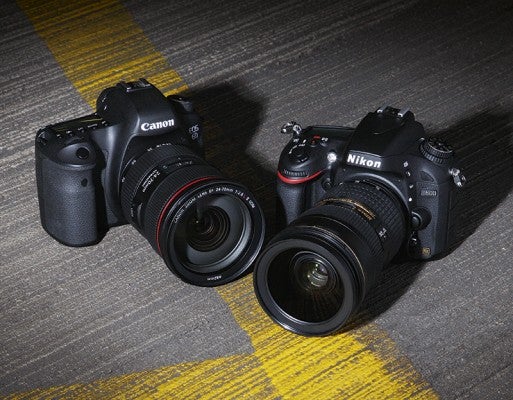Canon EOS 6D vs. Nikon D600 ? Design and Performance
Design
The D600 and 6D are the most compact full frame DSLRs we’ve seen, they are closer in size to their higher-end APS-C DSLR stablemates as opposed to either the Canon EOS 5D Mk III or Nikon D800.
Both use magnesium alloy in their construction, but not to the same extent as either of the two DSLRs mentioned above, with the Canon 6D featuring magnesium alloy plates on the front and rear, while with the D600, Nikon has opted for the top and rear plates, with the remainder on both models constructed from quality high-impact plastics.
Both offer weather-sealing, with the Nikon D600 claimed to feature the same level as the D800, while the Canon EOS 6D comes up a little short compared to the 5D MkIII. Overall, the 6D tips the scales at 770g while the D600 is slightly heavier at 850g, making them only a little bit heavier than either the 60D or D7000.
When it comes to fit and finish, both cameras don’t have quite the same ultra-rugged feel of either the 5D Mk III or D800, but that’s to be expected at the price and both leave you in no doubt that that they are quality pieces of kit.
Decent-sized handgrips can be found on both models, providing a firm and comfortable grip when shooting with a variety of lenses. Overall though, the general consensus was that the Canon 6D delivers a slightly more pleasing feel when you pick it up, though this is only marginal.
Aimed at those upgrading from an APS-C DSLR, it’s no surprise to see that both cameras take the design cues and exterior control layout from these models, with the Canon EOS 6D mimicking the way the 60D’s controls are laid out to some extent, while it’s a similar story with the D600 and the D7000. This means that plenty of exterior shooting controls can be quickly accessed on both models, such as ISO, Drive and White Balance, for example, with both of them featuring a mode dial and LCD display on the top plate.
Both cameras are a pleasure to shoot with – main shooting controls fall to the hand, while both have a comprehensive menu system that allows you to fine-tune the settings of each to your liking. Out of the two however, the Nikon D600 is the slightly more intuitive for the newcomer, but existing owners looking to upgrade will feel right at home on either camera. If you’re looking at either of these cameras as a second body to your full frame kit, the slightly different button arrangement on both models will take a little getting used to when swapping between camera bodies.
Performance
When you look through the viewfinder of each camera, both models see their AF points grouped quite tightly in the centre of the frame, with the Canon EOS 6D‘s 11-point arrangement looking noticeably more sparse than the D600’s 39 points. You’ll find that you’ll have to focus then recompose a lot more with the 6D than the D600 thanks to the broader coverage offered by the Nikon, but this will be the case with both cameras when the main point of interest is off-centre.
AF acquirement is fast on both models – the Canon EOS 6D (provided you use the central cross-type AF sensor) has the edge in low light thanks to a detection range going down to -3 EV compared to -1 EV on the Nikon D600, but with the nine cross-type sensors offered by the Nikon, it edges when it comes to most shooting situations.
If you intend to shoot a lot of action, the D600 has the edge again. Provided that your subject also sticks relatively close to the centre of the frame, the D600 offers similar advanced focus-tracking options as its pro stablemates, being able to track subjects across its 39 AF points, using its Scene Recognition System to help maintain focus.
Both cameras offer large rear displays, but the Canon EOS 6D is the winner here. While the screen of the Nikon D600 looks fine in isolation, providing a decent amount of sharpness, it’s only when it’s placed next to the 6D’s display that their differences become pronounced. The Nikon D600’s screen renders a fairly noticeable green cast compared to the 6D, while it can’t quite match it for crispness and contrast either. That’s also not forgetting the 3:2 aspect ratio of the 6D’s display.
As far as burst shooting goes, both offer fairly conservative continuous shooting modes, with the D600 capable of shooting up to 5.5fps (frames per second) and the Canon EOS 6D being a touch slower at 4.5fps. In use with a Class 10 installed, the 6D can sustain this burst for 90 large JPEG files compared to 42 for the Nikon D600, while it’s a dead heat when shooting Raw, with both capturing 16 files before the buffer slows.





